Human Activity Recognition using LSTMs on Android | TensorFlow for Hackers (Part VI)
— Deep Learning, Neural Networks, TensorFlow, Python — 3 min read
Share
Ever wondered how your smartphone, smartwatch or wristband knows when you’re walking, running or sitting? Well, your device probably has multiple sensors that give various information. GPS, audio (i.e. microphones), image (i.e. cameras), direction (i.e. compasses) and acceleration sensors are very common nowadays.
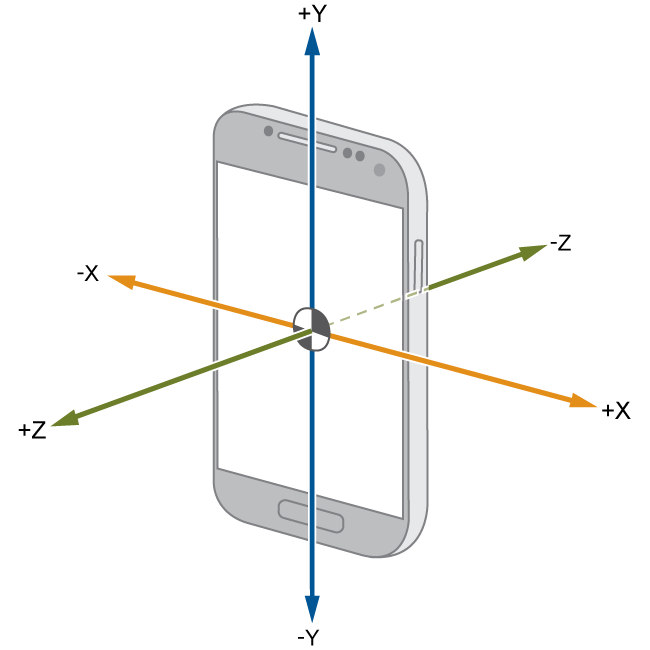 source: Mathworks
source: Mathworks
We will use data collected from accelerometer sensors. Virtually every modern smartphone has a tri-axial accelerometer that measures acceleration in all three spatial dimensions. Additionally, accelerometers can detect device orientation.
In this part of the series, we will train an LSTM Neural Network (implemented in TensorFlow) for Human Activity Recognition (HAR) from accelerometer data. The trained model will be exported/saved and added to an Android app. We will learn how to use it for inference from Java.
The source code for this part is available (including the Android app) on GitHub.
The data
We will use data provided by the Wireless Sensor Data Mining (WISDM) Lab. It can be download from here. The dataset was collected in controlled, laboratory setting. The lab provides another dataset collected from real-world usage of a smartphone app. You’re free to use/explore it as well. Here’s a video that presents how a similar dataset was collected:
Our dataset contains 1,098,207 rows and 6 columns. There are no missing values. There are 6 activities that we’ll try to recognize: Walking, Jogging, Upstairs, Downstairs, Sitting, Standing. Let’s have a closer look at the data:
1import pandas as pd2import numpy as np3import pickle4import matplotlib.pyplot as plt5from scipy import stats6import tensorflow as tf7import seaborn as sns8from pylab import rcParams9from sklearn import metrics10from sklearn.model_selection import train_test_split1112%matplotlib inline1314sns.set(style='whitegrid', palette='muted', font_scale=1.5)1516rcParams['figure.figsize'] = 14, 81718RANDOM_SEED = 421columns = ['user','activity','timestamp', 'x-axis', 'y-axis', 'z-axis']2df = pd.read_csv('data/WISDM_ar_v1.1_raw.txt', header = None, names = columns)3df = df.dropna()1df.head()| user | activity | timestamp | x-axis | y-axis | z-axis | |
|---|---|---|---|---|---|---|
| 0 | 33 | Jogging | 49105962326000 | -0.694638 | 12.680544 | 0.503953 |
| 1 | 33 | Jogging | 49106062271000 | 5.012288 | 11.264028 | 0.953424 |
| 2 | 33 | Jogging | 49106112167000 | 4.903325 | 10.882658 | -0.081722 |
| 3 | 33 | Jogging | 49106222305000 | -0.612916 | 18.496431 | 3.023717 |
| 4 | 33 | Jogging | 49106332290000 | -1.184970 | 12.108489 | 7.205164 |
Exploration
The columns we will be most interested in are activity, x-axis, y-axis and z-axis. Let’s dive into the data:
1df['activity'].value_counts().plot(kind='bar', title='Training examples by activity type');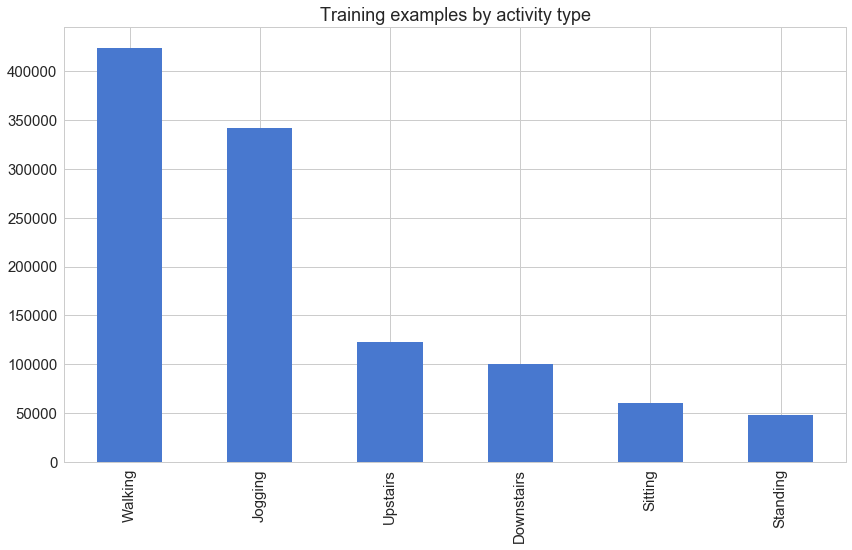
The columns we will be most interested in are activity, x-axis, y-axis and z-axis. Let’s dive into the data:
1df['user'].value_counts().plot(kind='bar', title='Training examples by user');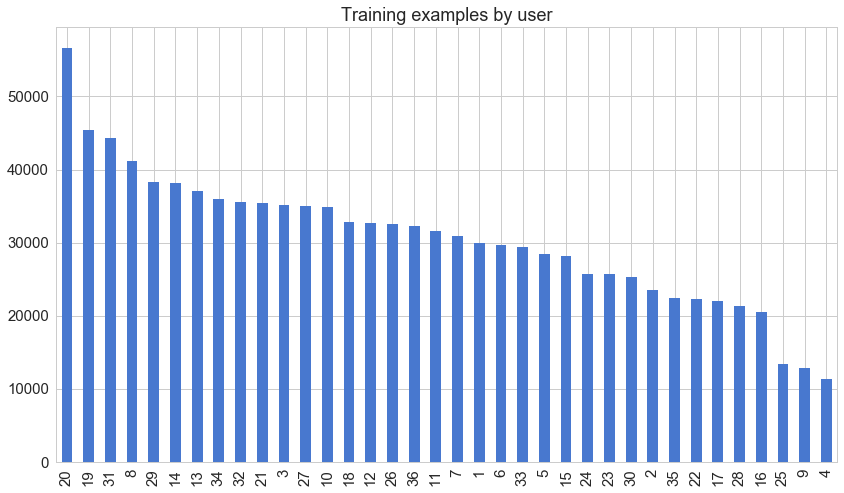
I wonder whether or not number 4 received the same paycheck as number 20. Now, for some accelerometer data:
1def plot_activity(activity, df):2 data = df[df['activity'] == activity][['x-axis', 'y-axis', 'z-axis']][:200]3 axis = data.plot(subplots=True, figsize=(16, 12),4 title=activity)5 for ax in axis:6 ax.legend(loc='lower left', bbox_to_anchor=(1.0, 0.5))1plot_activity("Sitting", df)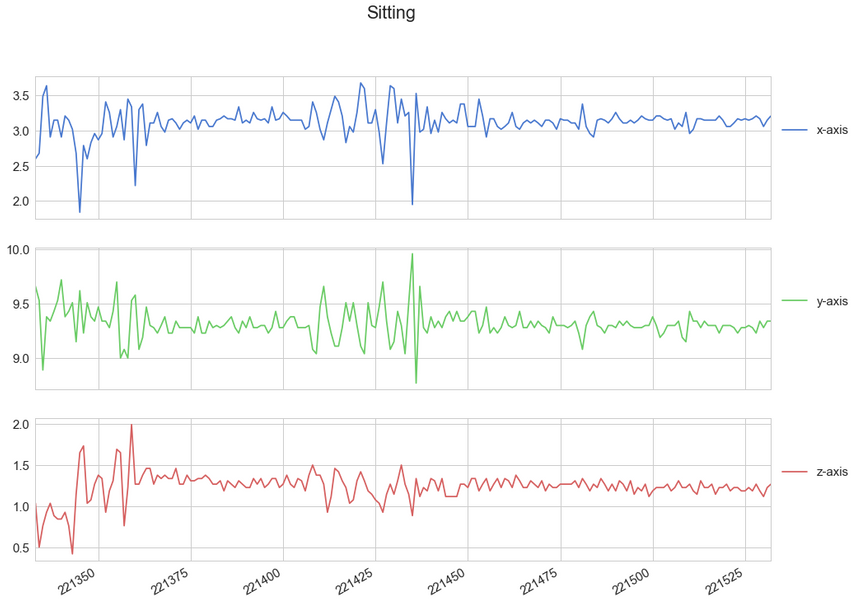
1plot_activity("Standing", df)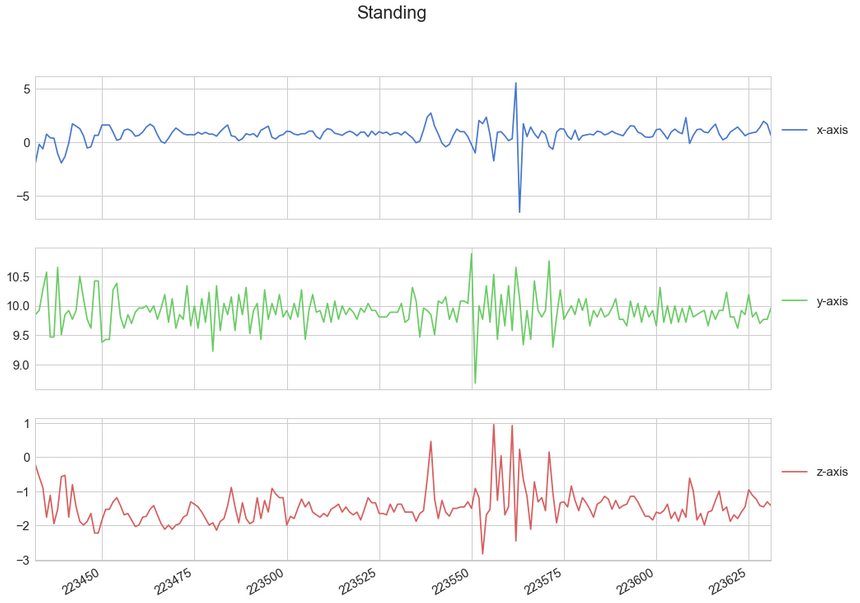
1plot_activity("Walking", df)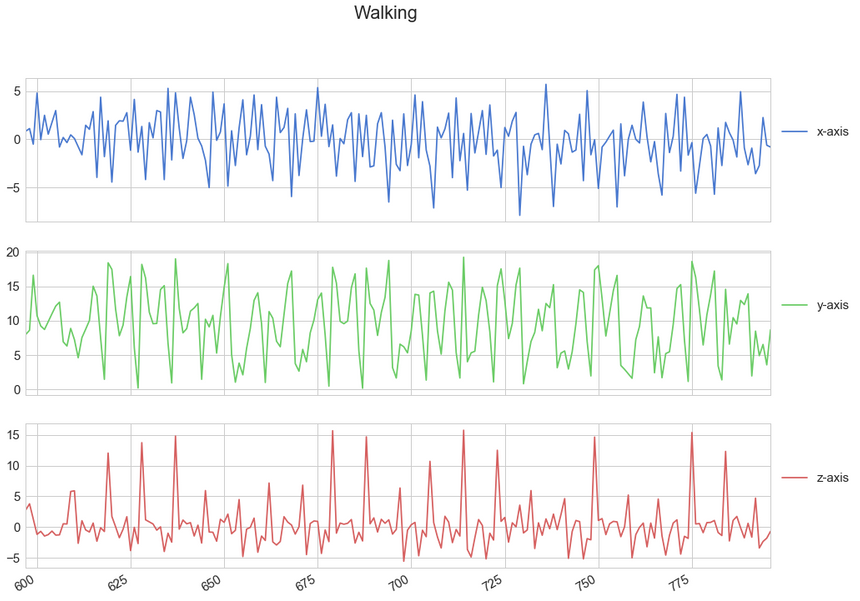
1plot_activity("Jogging", df)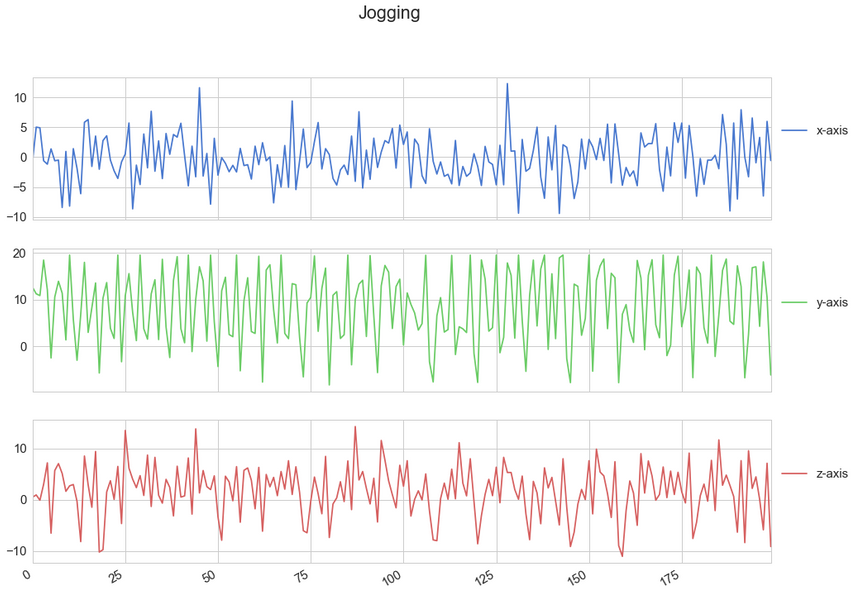
It seems reasonable to assume that this data might be used to train a model that can distinguish between the different kinds of activities. Well, at least the first 200 entries of each activity look that way.
Data preprocessing
Our LSTM (covered in the previous part of the series) model expects fixed-length sequences as training data. We’ll use a familiar method for generating these. Each generated sequence contains 200 training examples:
1N_TIME_STEPS = 2002N_FEATURES = 33step = 204segments = []5labels = []6for i in range(0, len(df) - N_TIME_STEPS, step):7 xs = df['x-axis'].values[i: i + N_TIME_STEPS]8 ys = df['y-axis'].values[i: i + N_TIME_STEPS]9 zs = df['z-axis'].values[i: i + N_TIME_STEPS]10 label = stats.mode(df['activity'][i: i + N_TIME_STEPS])[0][0]11 segments.append([xs, ys, zs])12 labels.append(label)1np.array(segments).shape1(54901, 3, 200)Our training dataset has drastically reduced size after the transformation. Note that we take the most common activity and assign it as a label for the sequence.
The shape of our tensor looks kinda strange. Let’s transform it into sequences of 200 rows, each containing x, y and z. Let’s apply a one-hot encoding to our labels, as well:
1reshaped_segments = np.asarray(segments, dtype= np.float32).reshape(-1, N_TIME_STEPS, N_FEATURES)2labels = np.asarray(pd.get_dummies(labels), dtype = np.float32)1reshaped_segments.shape1(54901, 200, 3)1labels[0]1array([ 0., 1., 0., 0., 0., 0.], dtype=float32)Finally, let’s split the data into training and test (20%) set:
1X_train, X_test, y_train, y_test = train_test_split(2 reshaped_segments, labels, test_size=0.2, random_state=RANDOM_SEED)Building the model
Our model contains 2 fully-connected and 2 LSTM layers (stacked on each other) with 64 units each:
1N_CLASSES = 62N_HIDDEN_UNITS = 641def create_LSTM_model(inputs):2 W = {3 'hidden': tf.Variable(tf.random_normal([N_FEATURES, N_HIDDEN_UNITS])),4 'output': tf.Variable(tf.random_normal([N_HIDDEN_UNITS, N_CLASSES]))5 }6 biases = {7 'hidden': tf.Variable(tf.random_normal([N_HIDDEN_UNITS], mean=1.0)),8 'output': tf.Variable(tf.random_normal([N_CLASSES]))9 }1011 X = tf.transpose(inputs, [1, 0, 2])12 X = tf.reshape(X, [-1, N_FEATURES])13 hidden = tf.nn.relu(tf.matmul(X, W['hidden']) + biases['hidden'])14 hidden = tf.split(hidden, N_TIME_STEPS, 0)1516 # Stack 2 LSTM layers17 lstm_layers = [tf.contrib.rnn.BasicLSTMCell(N_HIDDEN_UNITS, forget_bias=1.0) for _ in range(2)]18 lstm_layers = tf.contrib.rnn.MultiRNNCell(lstm_layers)1920 outputs, _ = tf.contrib.rnn.static_rnn(lstm_layers, hidden, dtype=tf.float32)2122 # Get output for the last time step23 lstm_last_output = outputs[-1]2425 return tf.matmul(lstm_last_output, W['output']) + biases['output']Now, let create placeholders for our model:
1tf.reset_default_graph()23X = tf.placeholder(tf.float32, [None, N_TIME_STEPS, N_FEATURES], name="input")4Y = tf.placeholder(tf.float32, [None, N_CLASSES])Note that we named the input tensor, that will be useful when using the model from Android. Creating the model:
1pred_Y = create_LSTM_model(X)23pred_softmax = tf.nn.softmax(pred_Y, name="y_")Again, we must properly name the tensor from which we will obtain predictions. We will use L2 regularization and that must be noted in our loss op:
1L2_LOSS = 0.001523l2 = L2_LOSS * \4 sum(tf.nn.l2_loss(tf_var) for tf_var in tf.trainable_variables())56loss = tf.reduce_mean(tf.nn.softmax_cross_entropy_with_logits(logits = pred_Y, labels = Y)) + l2Finally, let’s define optimizer and accuracy ops:
1LEARNING_RATE = 0.002523optimizer = tf.train.AdamOptimizer(learning_rate=LEARNING_RATE).minimize(loss)45correct_pred = tf.equal(tf.argmax(pred_softmax, 1), tf.argmax(Y, 1))6accuracy = tf.reduce_mean(tf.cast(correct_pred, dtype=tf.float32))Training
The training part contains a lot of TensorFlow boilerplate. We will train our model for 50 epochs and keep track of accuracy and error:
1N_EPOCHS = 502BATCH_SIZE = 10241saver = tf.train.Saver()23history = dict(train_loss=[],4 train_acc=[],5 test_loss=[],6 test_acc=[])78sess=tf.InteractiveSession()9sess.run(tf.global_variables_initializer())1011train_count = len(X_train)1213for i in range(1, N_EPOCHS + 1):14 for start, end in zip(range(0, train_count, BATCH_SIZE),15 range(BATCH_SIZE, train_count + 1,BATCH_SIZE)):16 sess.run(optimizer, feed_dict={X: X_train[start:end],17 Y: y_train[start:end]})1819 _, acc_train, loss_train = sess.run([pred_softmax, accuracy, loss], feed_dict={20 X: X_train, Y: y_train})2122 _, acc_test, loss_test = sess.run([pred_softmax, accuracy, loss], feed_dict={23 X: X_test, Y: y_test})2425 history['train_loss'].append(loss_train)26 history['train_acc'].append(acc_train)27 history['test_loss'].append(loss_test)28 history['test_acc'].append(acc_test)2930 if i != 1 and i % 10 != 0:31 continue3233 print(f'epoch: {i} test accuracy: {acc_test} loss: {loss_test}')3435predictions, acc_final, loss_final = sess.run([pred_softmax, accuracy, loss], feed_dict={X: X_test, Y: y_test})3637print()38print(f'final results: accuracy: {acc_final} loss: {loss_final}')1epoch: 1 test accuracy: 0.7736998796463013 loss: 1.27736544609069822epoch: 10 test accuracy: 0.9388942122459412 loss: 0.56125330924987793epoch: 20 test accuracy: 0.9574717283248901 loss: 0.39165124297142034epoch: 30 test accuracy: 0.9693103432655334 loss: 0.29352602362632755epoch: 40 test accuracy: 0.9747744202613831 loss: 0.2502188980579376Whew, that was a lot of training. Do you feel thirsty? Let’s store our precious model to disk:
1pickle.dump(predictions, open("predictions.p", "wb"))2pickle.dump(history, open("history.p", "wb"))3tf.train.write_graph(sess.graph_def, '.', '/media/old-tf-hackers-6/checkpoint/har.pbtxt')4saver.save(sess, save_path = "/media/old-tf-hackers-6/checkpoint/har.ckpt")5sess.close()And loading it back:
1history = pickle.load(open("history.p", "rb"))2predictions = pickle.load(open("predictions.p", "rb"))Evaluation
1plt.figure(figsize=(12, 8))23plt.plot(np.array(history['train_loss']), "r--", label="Train loss")4plt.plot(np.array(history['train_acc']), "g--", label="Train accuracy")56plt.plot(np.array(history['test_loss']), "r-", label="Test loss")7plt.plot(np.array(history['test_acc']), "g-", label="Test accuracy")89plt.title("Training session's progress over iterations")10plt.legend(loc='upper right', shadow=True)11plt.ylabel('Training Progress (Loss or Accuracy values)')12plt.xlabel('Training Epoch')13plt.ylim(0)1415plt.show()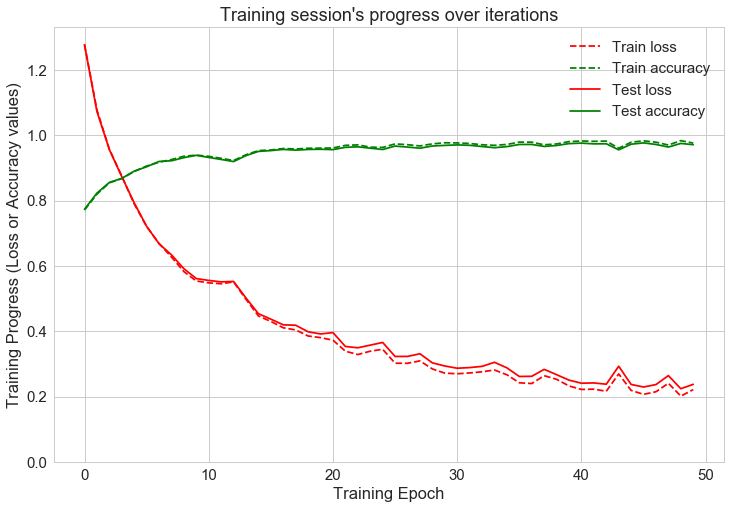
Our model seems to learn well with accuracy reaching above 97% and loss hovering at around 0.2. Let’s have a look at the confusion matrix for the model’s predictions:
1LABELS = ['Downstairs', 'Jogging', 'Sitting', 'Standing', 'Upstairs', 'Walking']1max_test = np.argmax(y_test, axis=1)2max_predictions = np.argmax(predictions, axis=1)3confusion_matrix = metrics.confusion_matrix(max_test, max_predictions)45plt.figure(figsize=(16, 14))6sns.heatmap(confusion_matrix, xticklabels=LABELS, yticklabels=LABELS, annot=True, fmt="d");7plt.title("Confusion matrix")8plt.ylabel('True label')9plt.xlabel('Predicted label')10plt.show();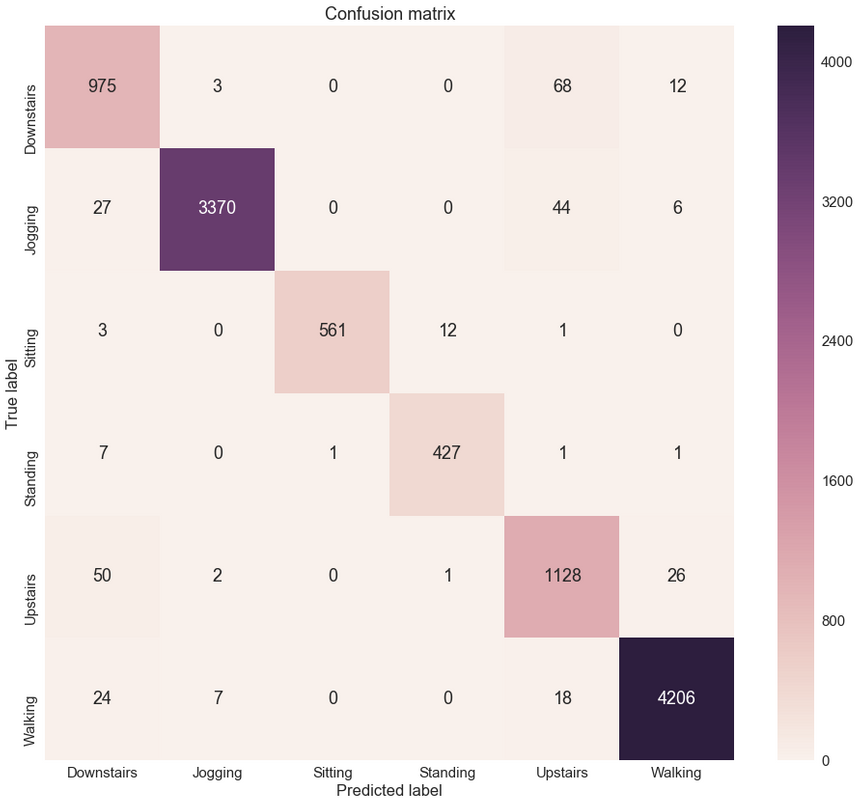
Again, it looks like our model performs real good. Some notable exceptions include the misclassification of Upstairs for Downstairs and vice versa. Jogging seems to fail us from time to time as well!
Exporting the model
Now that most of the hard work is done we must export our model in a way that TensorFlow for Android will understand it:
1from tensorflow.python.tools import freeze_graph23MODEL_NAME = 'har'45input_graph_path = 'checkpoint/' + MODEL_NAME+'.pbtxt'6checkpoint_path = '/media/old-tf-hackers-6/checkpoint/' +MODEL_NAME+'.ckpt'7restore_op_name = "save/restore_all"8filename_tensor_name = "save/Const:0"9output_frozen_graph_name = 'frozen_'+MODEL_NAME+'.pb'1011freeze_graph.freeze_graph(input_graph_path, input_saver="",12 input_binary=False, input_checkpoint=checkpoint_path,13 output_node_names="y_", restore_op_name="save/restore_all",14 filename_tensor_name="save/Const:0",15 output_graph=output_frozen_graph_name, clear_devices=True, initializer_nodes="")1INFO:tensorflow:Restoring parameters from /media/old-tf-hackers-6/checkpoint/har.ckpt2INFO:tensorflow:Froze 8 variables.3Converted 8 variables to const ops.46862 ops in the final graph.A sample app that uses the exported model can be found on GitHub. It is based heavily based on the Activity Recognition app by Aaqib Saeed. Our app uses the text-to-speech Android API to tell you what the model predicts at some interval and includes our pre-trained model.
The most notable parts of the Java code include defining our input and output dimensions and names:
1String INPUT_NODE = "inputs";2String[] OUTPUT_NODES = {"y_"};3String OUTPUT_NODE = "y_";4long[] INPUT_SIZE = {1, 200, 3};5int OUTPUT_SIZE = 6;Creating the TensorFlowInferenceInterface:
1inferenceInterface = new TensorFlowInferenceInterface(context.getAssets(), MODEL_FILE);And making the predictions:
1public float[] predictProbabilities(float[] data) {2 float[] result = new float[OUTPUT_SIZE];3 inferenceInterface.feed(INPUT_NODE, data, INPUT_SIZE);4 inferenceInterface.run(OUTPUT_NODES);5 inferenceInterface.fetch(OUTPUT_NODE, result);67 //Downstairs Jogging Sitting Standing Upstairs Walking8 return result;9}The result is a float array that contains the probability for each possible activity, according to our model.
Conclusion
We’ve built an LSTM model that can predict human activity from 200 time-step sequence with over 97% accuracy on the test set. The model was exported and used in an Android app. I had a lot of fun testing it on my phone, but it seems like more fine tuning (or changing the dataset) is required. Did you try the app? Can you improve it?
The source code for this part is available (including the Android app) on GitHub.
References
Share
Want to be a Machine Learning expert?
You'll never get spam from me